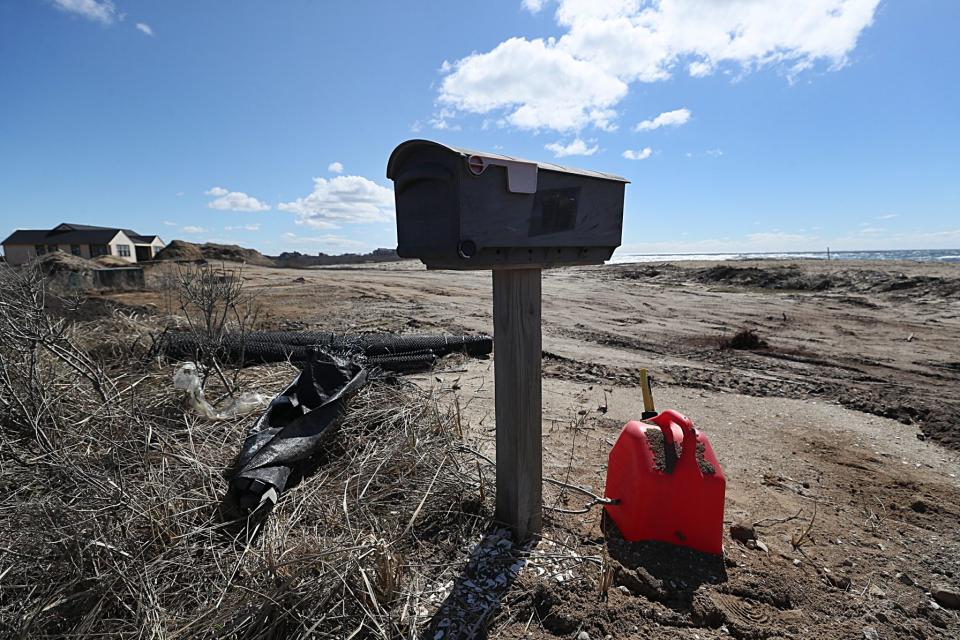With multimillion-dollar homes at risk of falling into the sea, Nantucket grapples with who pays for climate projects and how much

Earlier this year, a waterfront house on Nantucket made headlines after its listing price plummeted 74% in the span of about six months. The three-bedroom, two-bathroom home dropped from $2.3 million all the way down to $600,000 after 70 feet of nearby shoreline was eaten away in Nor’easter, putting the property at risk.
But the ranch-style house on the southern shore of the island off the coast of Massachusetts isn’t an anomaly. And with thousands of structures at risk, the issue of who pays for climate projects on Nantucket, and how much, is already playing out.
Once the heart of New England’s whaling industry, Nantucket has evolved into a summer haven for the rich, with only a small band of locals staying through the winter. Nearly 70% of homes on the island are owned by people who stay for part of the year, according to the Nantucket Current.
And those homes are pricey. According to Zillow, the average value for a single-family home on the island is nearly $2.9 million—compared to about $650,000 for the rest of Massachusetts. Of the 26 waterfront properties listed on Zillow, most of the listing prices range from $10 million to $20 million, with one listed at $35 million. But home values are now increasingly under scrutiny.
Shelly Lockwood, a real estate agent on Nantucket, told Fortune she began to get frustrated last fall when she started seeing listing prices for waterfront properties on the island that she viewed as “really wrong.” So in conjunction with Nantucket’s Coastal Resilience Advisory Committee, she helped launch a class for real estate agents to help them reprice at-risk homes.
“It’s just not a good look,” she said. “If I bought a house for $10 million and it fell in the water and somebody didn't tell me, I'd be pretty upset.”
Attorney Cris Farley told Fortune that he’s been helping homeowners reduce their property taxes to reflect losses in home value caused by erosion. That requires an abatement from the town assessor's office, which Farley said should take into account the long-term erosion of the beach a property sits on.
However, if a substantial amount of homes lose value, property tax revenue for the entire town could take a hit, at a time when tax dollars may be sorely needed to tackle the problems affecting waterfront homeowners.
Who pays
That cost to taxpayers has already been priced out. In 2021, Nantucket adopted a coastal resiliency plan (CRP) outlining projects totaling almost $1 billion that would help the island withstand some of the fallout from erosion and sea-level rise. Part of that plan involved segmenting the island into “coastal resiliency districts”—essentially dividing Nantucket into different zones according to their level of risk and unique needs.
Leah Hill, the coastal resilience coordinator for the town, told the Boston Globe that if Nantucket fails to reduce coastal risks by 2070, nearly 2,400 structures are at risk from coastal flooding and erosion, with damages costing $3.4 billion a year.
One idea that’s come up among town officials is to impose betterment fees on property owners who stand to benefit the most from resiliency projects, which would lower the cost for the town as well as the taxpayers who are less affected.
Vincent Murphy, sustainability programs manager for the town, told Fortune in an email that many of the projects outlined in the CRP are small, with very localized benefits, which was the primary rationale behind the idea of betterment fees.
“When the Town and neighbors benefit from a project and agree to undertake works together, then the costs would be shared,” Murphy said. "The Town would pay for a portion, and the neighbors who benefit also pay accordingly.”
Exactly who helps pay for projects, and how much they pay, would be determined on a case-by-case basis based on how many beneficiaries a project has, and the degree to which they benefit, Murphy said. Payment would be made over a set period up to 20 years.
But not everyone on Nantucket is on board with the concept. When a resolution on an article about betterment fees came up for a vote at last month's town meeting, voters pushed back on the plan and questioned whether it was fair to make some property owners shoulder more of the cost than others. While the roadmap for the coastal resilience districts moved forward, a vote on betterment fees was postponed.
“The way it is set up, the entire island goes under this and it's broken into districts, and those districts are charged for projects under betterments,” Bobby DeCosta, a former select board member, said at the town meeting, according to the Nantucket Current. “That singles out taxpayers in those areas, people who own property by ponds and beaches, and who pay most of the taxes for us already.”
This story was originally featured on Fortune.com

 Yahoo Finance
Yahoo Finance 